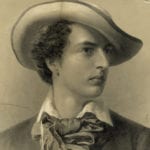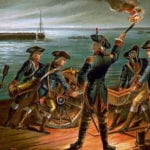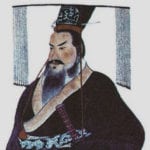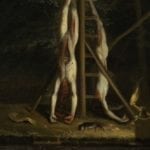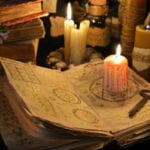 Travel
Travel  Travel
Travel  Creepy
Creepy 10 Haunted Places in Alabama
 History
History Top 10 Tragic Facts about England’s 9 Days Queen
 Food
Food 10 Weird Foods Inspired by Your Favorite Movies
 Religion
Religion 10 Mind-Blowing Claims and Messages Hidden in the Bible Code
 Facts
Facts 10 Things You Never Knew about the History of Gambling
 Weird Stuff
Weird Stuff 10 Cool and Creepy Facts about Collecting Tears
 Humans
Humans The Ten Most Lethal Gunslingers of the Old West
 Misconceptions
Misconceptions 10 Phony Myths and Urban Legends That Just Won’t Die
 History
History 10 Amazing Roman Epitaphs
 Travel
Travel Top 10 Religious Architectural Marvels
 Creepy
Creepy 10 Haunted Places in Alabama
 History
History Top 10 Tragic Facts about England’s 9 Days Queen
Who's Behind Listverse?

Jamie Frater
Head Editor
Jamie founded Listverse due to an insatiable desire to share fascinating, obscure, and bizarre facts. He has been a guest speaker on numerous national radio and television stations and is a five time published author.
More About Us Food
Food 10 Weird Foods Inspired by Your Favorite Movies
 Religion
Religion 10 Mind-Blowing Claims and Messages Hidden in the Bible Code
 Facts
Facts 10 Things You Never Knew about the History of Gambling
 Weird Stuff
Weird Stuff 10 Cool and Creepy Facts about Collecting Tears
 Humans
Humans The Ten Most Lethal Gunslingers of the Old West
 Misconceptions
Misconceptions 10 Phony Myths and Urban Legends That Just Won’t Die
 History
History 10 Amazing Roman Epitaphs
10 Of The Wildest Parties In History
If you think the beer pong frat extravaganza you’re already planning for the day before Spring Break is going to be impressive, you’d be hard-pressed to follow these legendary bashes. Then again, maybe you shouldn’t try—hangovers exist for the same reason the police do. Perhaps it’s better to dream from afar.
10 Count Etienne de Beaumont’s 1924 Automotive Ball
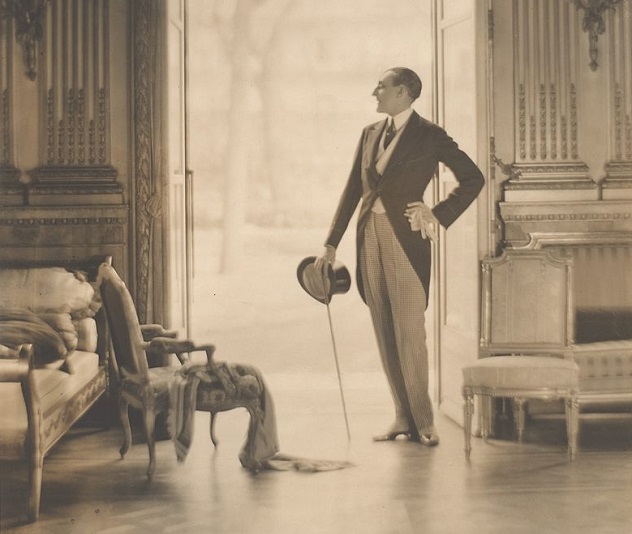
Beaumont and his Edith were renowned throughout Europe and North America for throwing some of the greatest parties ever seen. Their masquerade ball was celebrated at their mansion on Rue Duroc in Paris every summer. Their 1924 party may not have been any more extravagant than their others, but it featured possibly the most outlandish theme—all guests had to dress up as a car. Photos of Sara and Gerald Murphy, who were good friends of the Beaumonts, in their costumes are still around to this day.
The food was lavish French cuisine, of course, with plenty of wine and champagne. Guest Raymond Radiguet was so exhilarated by the Beaumonts’ annual parties that he wrote a novel about them, Le Bal du Comte d’Orgel. Throughout the banquet, costumed performers would run in making automotive sounds and act out vignettes about various vehicles. Perhaps the only Beaumont part wilder than this was another hosted in the 1920s in which every guest was required to leave exposed the part of his or her anatomy he or she deemed the most interesting.
9 The Papal Conclaves Of 1644 And 1667
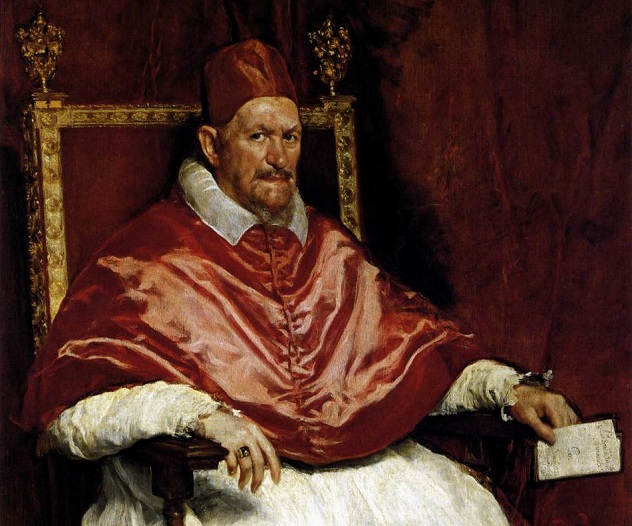
When a pope dies, Italy goes into deep mourning. If the subsequent conclave takes a long time to elect a successor, the country very quickly loses its temper. The conclave of 1644 lasted from August 9–September 15, 1644, delayed by the previous pope, Urban VIII, appointing three members of his own family to cardinals. Two of these men were brothers Antonio and Francesco Barberini, who bickered with each other like Regan and Goneril in King Lear, and for the same reason. Finally, after several bribes from France and Spain, Giovanni Battista Pamphili was elected and chose the amusing regnal Innocent X. The entire Catholic world rejoiced, but nowhere was the celebration more bacchanalian than in Rome.
This conclave and the next, which lasted from January–April 1655, were still fresh in a lot of memories when 1667’s 18-day conclave came about in June. Eighteen days was still found to be far longer than any Catholic wanted to wait, and when Giulio Rospigliosi was elected Clement IX, Rome rejoiced in the same manner as in 1644.
The city of Rome decided to celebrate these elections at La Fontana dei Leoni—the Lions’ Fountain—at the foot of the Cordonata in Piazza Ara Coeli, leading up to Piazza del Campidoglio at the top of the Capitoline Hill. The Cordonata is a giant, wide staircase designed by Michelangelo that allows cavalry to ascend to Campidoglio without dismounting. There is a lion of black basalt on either side of the Cordonata that spew water into a huge vase, and at dusk on the day after each election, the water from these fountains was replaced with wine and dispensed to revelers free of charge. The jubilant thronged Ara Coeli, the Cordonata, and up into Campidoglio throughout the night, dipping their goblets in the vases and drinking all they wanted.
8 The Premiere Of Les Noces
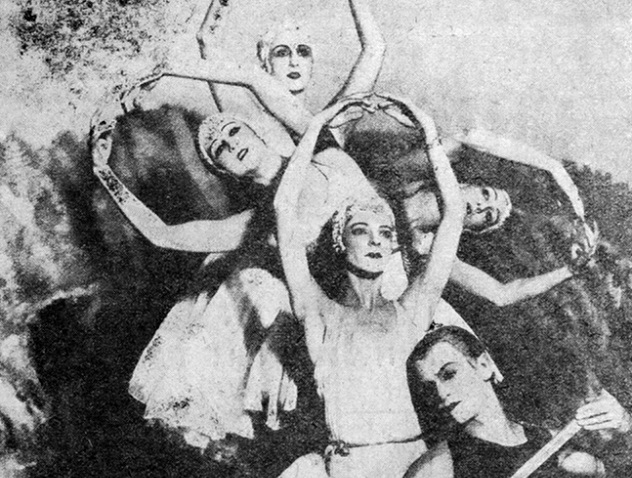
Igor Stravinsky’s ballet Les Noces (The Wedding) premiered at the Théâtre de la Gaîté in Paris on June 13, 1923 to great acclaim. Sara and Gerald Murphy—those friends of the Beaumonts from earlier—decided to throw a lavish party for Stravinsky and a host of the intellectual elite. Rather than rush an impromptu reception for that night, they announced throughout Paris that the party would be on July 1, on a barge on the Seine River.
With this much time to prepare and a lot of money, they went all out on food, drink, and decor. Five-star French chefs were hired to cook on-site and the champagne never ran out. Even more important than the food were the guests, all personal friends of the Murphys: Stravinsky, Impresario Sergei Diaghilev, choreographer Bronislav Nijinska, the entire troupe of the Ballet Russes, Pablo Picasso, F. Scott Fitzgerald, poet Tristan Tzara, risque novelist Raymond Radiguet, Cole Porter, and Jean Cocteau.
Sara Murphy wanted to decorate the barge with flowers, but the florists were closed on Sunday, so she bought a hoard of toys, fire trucks, dolls, clowns, stuffed animals, and toy trains. Picasso quickly decided these deserved to be a car wreck and piled them all together, topping it off with a cow on a fire truck ladder. This may have inspired Picasso’s sculpture of a monkey’s head from one of his son’s toy cars. The party lasted all night—artist Natalia Goncharova read palms, Cocteau kept terrifying people by screaming that the ship was sinking, and by dawn, conductor Ernest Ansermet took down the Murphy’s huge laurel wreath and a very drunk Stravinsky jumped through it. He called it the greatest night of his life.
7 Truman Capote’s Black And White Ball
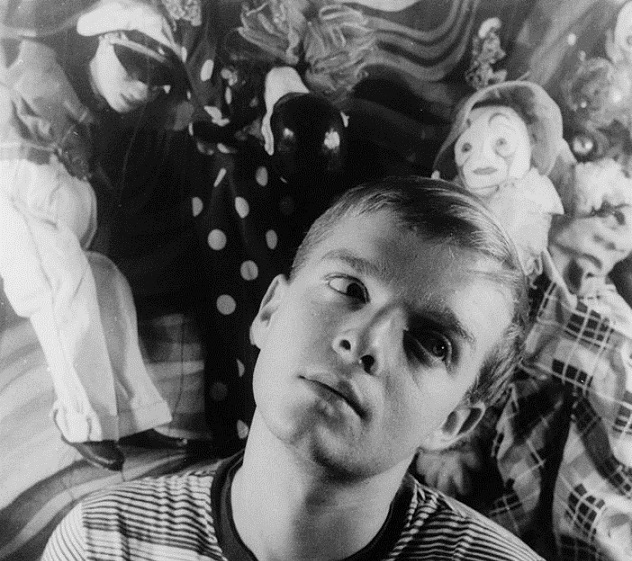
Capote was not one to be modest. He loved to remind people that one day he would be rich and famous and would throw all his friends a party they would never forget. When his novel In Cold Blood became a huge success in 1966, he found himself in the money and spent the next three months planning a masquerade ball. He chose New York City’s sumptuous Plaza Hotel and intended to decorate everything in stark black and white. The ball may have inspired Stanley Kubrick’s use of black and white sets in subsequent movies like 2001: A Space Odyssey and A Clockwork Orange.
Capote invited only the choicest of his friends, along with some celebrities he admired, including politicians, actors, and mostly writers. There was a strict dress code of only black or white, and everyone would be outfitted with a black or white mask if they did not bring one. Some wore elaborate unicorn head masks, while others wore cat-shaped masks. Capote countered the black and white decorum with shockingly crimson tablecloths, gold candelabras, and smilax vines with bright red berries.
The bill of fare consisted of several of Capote’s favorite dishes: sausage, scrambled eggs, biscuits, spaghetti and meatballs, chicken hash, and chocolate and fruit dessert pastries. The beverages were water and 450 bottles of Taittinger champagne. The guest of honor was Katharine Graham, the president of The Washington Post, who claimed that Capote only needed her as a prop. Guests included Henry Ford, Jr.; Prince Stanislaw Radziwill and his Princess, sister of the late John Kennedy; actress Candice Bergen, who wore a white rabbit mask; Norman Mailer; John Steinbeck; Phillip Roth; Irving Berlin; Vivien Leigh; and Frank Sinatra and Mia Farrow. It is understood that Sinatra’s departure heralded the official end of the party, since reporters were allowed to field questions outside the hotel and everyone knew Sinatra was there. When he finally tired and left at 2:45 in the morning, Capote pleaded for him to stay, since many of the partiers would follow Sinatra to Jilly’s Bar.
The party has been called the last great moment in New York City’s social history.
6 Nero’s Domus Aurea
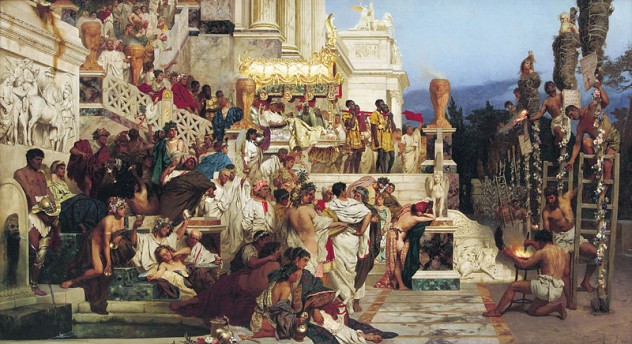
The Golden House was a luxury party manor Nero had built for his and his guests’ wanton prodigality, and he used it almost every day for four years. Scholars cannot yet agree on just how gigantic it was, but it covered at least 100 acres of the center of Rome, across the Palatine, Caelian, and Esquiline Hills. Today, it is buried under subsequent development and currently being excavated. New rooms are discovered all the time, with original frescoes and architecture untouched since Nero’s day.
It was well-known from history but had been condemned after Nero’s suicide and filled in and over with dirt. The opulence Nero had built for it is beyond belief, and the Golden House was one of the primary reasons for the final revolt that drove him from Rome. The Roman people were starving while Nero merrily ignored them, entertaining his rich friends and political acquaintances. The Domus may have covered 300 acres at its maximum, including an artificial lake, cattle pastures, and vast, manicured groves. These were the gardens through which Nero walked at night and had Christians tied to stakes, smeared with wax, and set on fire to light his path.
The main building included a giant dome and all the exterior walls were gold-plated. The interior walls and floors were stone overlaid with solid marble, trimmed with elephant ivory, and encrusted with diamonds, rubies, sapphires, and other precious stones. Nero commissioned a massive bronze statue to himself, the Colossus Neronis, which stood some 35 meters (116 ft) tall and was placed just outside the main entrance, inside a covered portico at the end of the Appian Way. There were 300 rooms in the Domus, and none of them were bedchambers.
The building was used for one thing only: partying. Incense was kept burning strongly throughout, and the central dining room was set on stone balls that could rotate the whole room with guests dining in it, in time with the changing of the sky’s color. Suetonius wrote that “all the dining rooms had ceilings of fretted ivory, the panels of which could slide back and let a rain of flowers, or of perfume from hidden sprinklers, fall on his guests.” The floors of the rooms were shaped in such a way that one room would capture the sunlight and the next would radiate it. There is very little information on any specific party that Nero threw in the Domus, but this is probably because there was a party every night. It is not overreaching to surmise that with feasts and alcohol came Roman sex orgies as well.
5 Belshazzar’s Feast
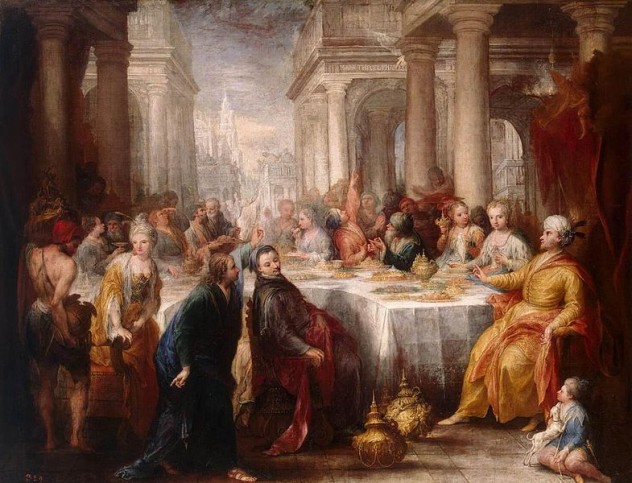
If for no other reason, you have to admire the Old Testament for how incredibly entertaining it is. Where else does God himself spoil the party? This feast occurred on the last night of Belshazzar’s reign over Babylon and ended with the Persian and Median conquest of the Babylonian capital and Belshazzar’s assassination in his sleep. The Book of Daniel is the only account of Belshazzar, but his existence has been corroborated in a few other texts or on artifacts.
Belshazzar, like so many other absolute rulers, has no concern whatever for humility, and he wines and dines 1,000 of his lordly friends. Once the party has been going well and everyone is already drunk, he orders the gold and silver goblets and bowls of the Jewish temple of Jerusalem to be brought in so his guests may drink beer from them. Why? For the same reason that people order the $25,000 sundae at Serendipity in New York City—it’s fun to indulge ourselves to excess when we have the luxury. What better way to enjoy abundant wine than by drinking from 24 karat gold? These vessels were meant for sacraments in the temple, the glorification of the Hebrew God. They became Babylon’s spoils after it conquered Jerusalem in 587 BC and razed Solomon’s Temple to the ground. Not only does gold look attractive and make us think the food will taste better, but it’s fun to thumb the nose at the conquered.
Belshazzar’s bill of fare for his guests was copious, to say the least, and consisted of unleavened barley bread, watermelons, cantaloupe (called “the Persian melon”), dates, almonds, pecans, and poultry, mutton, pork, beef, fish, and probably locusts for meat. Garlic and onions were, and still are, plentiful in the area and were used for seasoning. The Babylonians did not drink much wine, since grapes were difficult to cultivate in that area, so they drank barley beer. Drinking from some foreign god’s chalices was sure to make Belshazzar’s guests feel like gods themselves—then the hand of God showed up and ruined everything. Belshazzar’s kingdom was taken that very night and he himself killed by Cyrus the Great of Persia, whom Daniel may name Darius the Mede.
4 Paul Poiret’s Thousand And Second Night
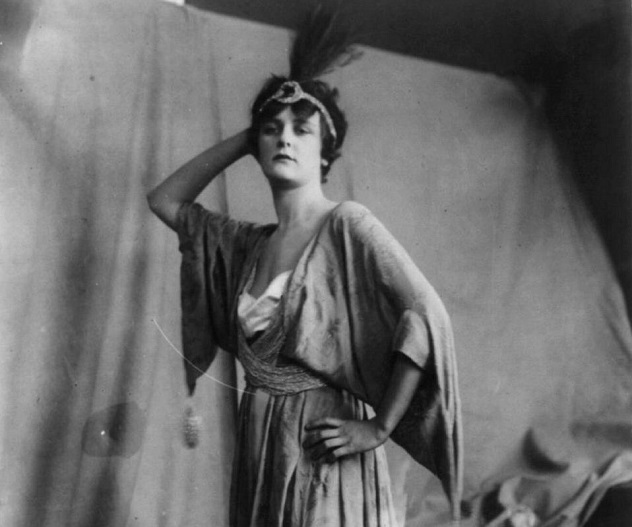
Poiret was the Lady Gaga of his day. He was a Parisian fashion designer who took France by storm with his modern dress designs when he eliminated the woman’s need to wear a corset in order to enhance her figure. He emphasized drapery instead of tightly tailoring the clothing to woman. On 24 June 1911, he finally debuted a new fragrance line, Parfums de Rosine, named after his daughter, and he had hyped this revelation for months by preparing the most elaborate party Paris would see in a very long time.
Held at his own villa in Paris, the theme was Persia—all 300 guests, men and women, were required to dress in florid Persian style. Think of Disney’s Aladdin and you’ve got a very good idea of the costumes. Those who could not supply their own were given one free of charge, but those who would not conform were forced to leave. There were live tropical birds of every color a feast fit for Belshazzar, complemented with red and white wine and champagne. Poiret greeted his guests wearing a fur-trimmed, ankle-length overdress and bejeweled turban. Poiret decorated his house like a sultan’s harem, with palm trees, huge tents housing the food, and lots of gold—Poiret’s favorite color—everywhere. Poiret’s wife Denise basked on an overstuffed divan inside a gold cage, where she laughed riotously now and then at the patrons.
3 Alexander At Persepolis
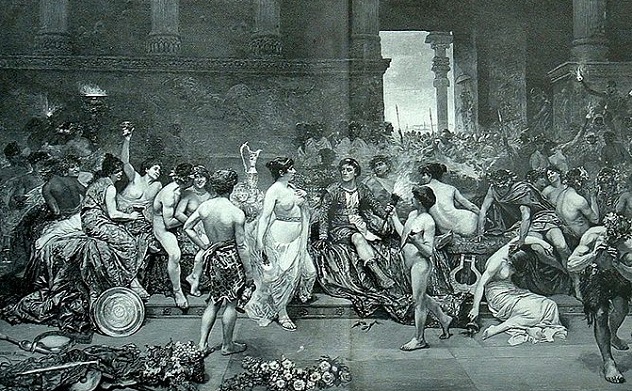
This was not merely a party. It was a rampage of hubristic debauchery of an intensity and scale that has not been seen since in the history of our species— murder, rape, unbridled drunkenness, and the looting of the entire city, culminating in Alexander’s personal and maniacally inebriated order to torch the Royal Palace.
In September 480 BC, a few weeks after Leonidas and his brave 300 (and about 7,000 others) died holding off Xerxes’s army of some 200,000, the victorious Persians marched on Athens and found it undefended and deserted. Athens then burned to the ground, and scholars will never agree on why. It may have been an accident when the Greeks were evacuating, or the Greeks may have done it themselves to deprive the Persians of supplies, or Xerxes may have done it in a rage. Greek propaganda persisted for a long time that Xerxes burned Athens down deliberately. By Alexander’s time, the Greeks wanted revenge, and Alexander may have knowingly given the order to burn down the palace out of a desire to placate his army of about 15,000. They were far from home and had been gone for five years, and he was always mindful of an atmosphere of mutiny.
Or it might simply have been the result of an atmosphere of alcoholic excess. It might have seemed to Alexander just a fun thing to do at the time. The Persian populace in the city had been thoroughly subjugated following the Battle at the Persian Gate. There, the Persians blocked Alexander’s invasion in a very narrow mountain pass, just as Leonidas at Thermopylae. Greek losses were heavy. This had not been another easy victory for history’s greatest general and his men now saw the Persians as playthings. Even though Persepolis surrendered and obeyed Alexander, he finally gave his men leave to butcher the Persian men, gang-rape and enslave the women, and ransack all buildings for Persepolis’s hoard of gold and gems that May.
Finally, Alexander ordered the central citadel—at the core of which stood Darius’s palace—razed to the ground. Much of it was stone, but enough of its foundation was wood for it to collapse. The only thing left standing of the palace and reception galleries where Darius entertained thousands of guests at a time were about forty stone pillars, still there today.
2 St. Petersburg, Russia, February 11–13, 1903
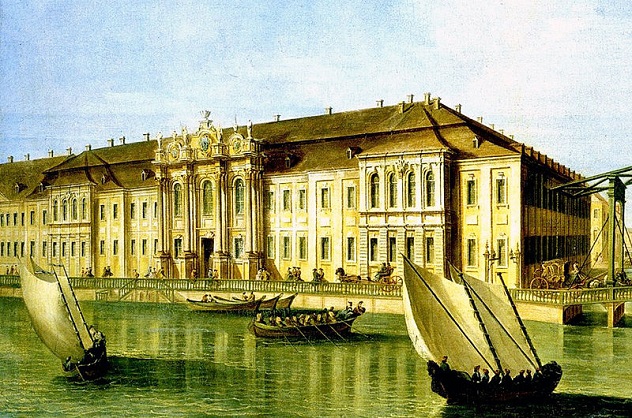
In the annals of merriment, no soiree was more convivial than the extravaganza Emperor Nicholas II and Empress Alexandra threw for their noble friends to celebrate being wealthy. At the time, the majority of the Russian people were starving and freezing to death throughout the country, and the ball was a major contributor to the revolution 14 years later. It was held in the monarchs’ official residence, the Winter Palace in St. Petersburg, and the theme was the 17th Century: Everyone was required to dress in the flamboyantly opulent costumes of Europe in the 1600s. Some dressed as Russian, German, and French kings and queens, and others as musketeers, complete with real rapiers.
Diamonds, precious stones, and priceless artifacts of the time period were brought from the Kremlin solely for the party-goers to enjoy wearing them. Nicholas and his wife dressed as Tsar Alexis I and Tsaritsa Maria Miloslavskaya. It is difficult to imagine the amount of luxury Nicholas could heap on his more than 200 guests when we consider that he was said to be worth a nominal $20 billion when he took the throne in 1894, but many sources claim a modern estimate of $290 to $300 billion in today’s US dollars. Nicholas was, more or less, worth Russia until the Russians got sick of what they viewed as his “let them eat cake” attitude.
The centerpiece of the first night’s festivities was a concert in the Hermitage theater inside the Palace, during which Mussorgsky’s Boris Godunov was performed with Feodor Chaliapin himself in the lead, followed by Minkus’s La Bayadere and Tchaikovsky’s Swan Lake. The guests were then treated to a Russian dance and a dinner so large it had to be held in three rooms—the Italian, Spanish, and Flemish rooms—where the food served corresponded to their respective cultures. Several bars throughout the palace served liquor, and tea and wine were present on every table. The court orchestra played Baroque music from all over Europe from behind a golden fence. Formal photographs were taken and this was the last time all the nobility of Russia was present for them.
Two nights later, the ball was celebrated again just as lavishly. Everyone feasted and danced until 1:00 AM, when the empress judged a costume contest. Russia has not seen this degree of splendor since.
1 La Sagra Dell’Uva
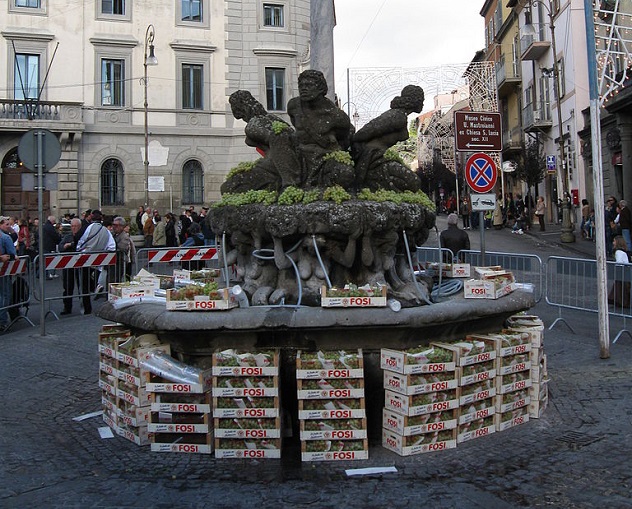
Every year on the first Sunday of October since 1924, the city of Marino, Italy has celebrated the arrival of Marcantonio Colonna, the admiral who defeated the Ottoman armada in the Gulf Of Corinth in 1571. Some 400 of the Marino townsfolk dress in the Renaissance garb of Colonna’s sailors, there is a jousting tournament, and every balcony, doorway, and terrace is strung with flower garlands. All the fountains are bedecked with vines of ripe grapes and you may eat as many of them as you like. If you want an actual meal, you need only browse the town and sample as you please—it’s all free.
The festival lasts from dawn to well into the dark of the next morning, but the highlight of the party comes at dusk. Just as the sun hits the horizon, the water is drained from the main fountain in the center of town, La Fontana dei Quattro Mori (“the Fountain of the Four Moors”), and sweet white wine is dispensed freely for everyone to drink as much as they want. The city spends about $250,000 on the wine alone. You are advised, however, to drink your fill and then lay low, because the crowd does get out of hand.
A week later, on the second Sunday, they celebrate their annual doughnut festival. The doughnuts are a local delicacy, ciambella al mosto, which are baked buns with raisins, rolled in sugar and “must” or pressed wine skins.
FlameHorse is a writer for Listverse.

